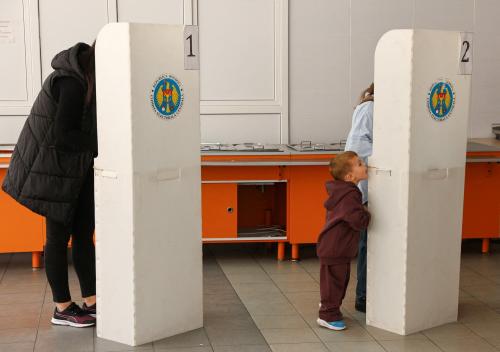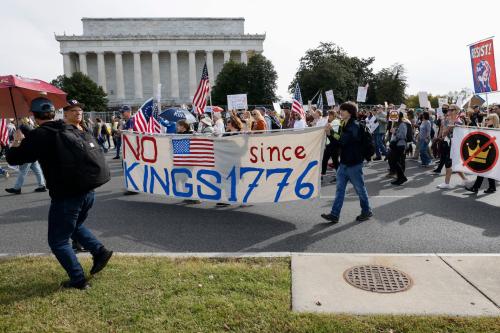The Nuclear Security Summits (NSSs) that have taken place since 2010 have transformed worldwide cooperation to secure nuclear weapons materials. However, as Sam Nunn, Richard Lugar and Des Browne highlighted in a recent Politico article, there is more to be done to consolidate the gains made towards a global nuclear architecture.
With the March 2016 NSS in Washington quickly approaching, several steps should be taken now to set the stage for the shift to a more sustainable model of nuclear security cooperation. Because the conditions of this final summit are not ideal for new breakthroughs, we propose some modest but useful steps that can aid in advancing the objectives set forth in the first NSS in 2010.
The summits’ successes
The NSS process began in 2009 when President Barack Obama called for a “new international effort to secure all vulnerable nuclear material around the world within four years.” The first summit in 2010 in Washington reaffirmed the goal of securing weapons-usable nuclear material worldwide. The 2012 NSS in Seoul reiterated the responsibility of states to secure nuclear materials by adhering to relevant conventions and participating in various global initiatives. The 2014 NSS in The Hague delivered more than a dozen noteworthy voluntary joint statements, which are multilateral political commitments that groups of countries agreed on during the summit.
Taken together, these summits have achieved notable results. They facilitated the removal of highly-enriched uranium and plutonium from 12 countries and two dozen nuclear facilities, increased security at nuclear storage sites around the world, created new teams to detect nuclear smuggling networks, and much more.
To-do’s
Next year’s NSS in Washington is expected to be the final summit. Several actions are key to meeting the principal objectives agreed to in 2010. Realizing these objectives before the 2016 summit would signal that the NSS process remains committed to accomplishing what it originally set out to do. This would make it easier to transition to a more sustainable model of nuclear security.
1. Get more states to ratify the amendment binding them to protect nuclear facilities and material
Needed actions begin with ratification of the amendment to the Convention for the Physical Protection of Nuclear Material (CPPNM). The amendment legally binds state parties to protect nuclear facilities and material in peaceful domestic use, storage, and transport. International Atomic Energy Agency (IAEA) Director General Yukiya Amano called the amendment a “major piece of unfinished business” that, once ratified by enough states, would be a vital part of the international legal framework to secure nuclear materials.
Twelve additional ratifications are needed to enter the amendment into force—an objective set by the 2010 NSS.
The good news is that progress is being made. Just a few weeks ago, Iceland ratified the amendment (Botswana, Turkey, Italy, and the United States have also done so recently). Following the U.S. ratification in June 2015, Secretary of State John Kerry released a statement saying that the United States would work with other countries to secure the additional ratifications and set the goal of achieving this by the end of the year. In April 2015, the IAEA, with support from Russia, held a workshop with representatives from Azerbaijan, Belarus, Kyrgyzstan, and Mongolia. These states, none of which have ratified the amendment, were briefed on how it could contribute to their nuclear security.
Taken together, these summits have achieved notable results.
2. Increase adherence from nuclear-armed states and others on strengthening nuclear security implementation
The joint statement with the highest number of signatories of the 2014 NSS was the joint statement titled “Strengthening nuclear security implementation,” which was signed by 35 states. Signatories agreed to subscribe to the IAEA’s “Objective and Essential Elements of a State’s Nuclear Security Regime” and committed to effectively and sustainably implementing the regime’s principles. These commitments mirror the 2010 NSS objective of “completion and implementation, as appropriate, of the guidance provided by the Nuclear Security Series,” which is a series of IAEA publications on measures to enhance nuclear security.
Although the joint statement secured a large number of signatories, notable states such as Russia, China, India, and Pakistan did not sign. Increasing the number of signatories, through their adherence to IAEA INFCIRC/869, would promote the implementation of the fundamental principles of nuclear security, a key goal of the summits.
3. Encourage deeper and wider implementation of UNSCR 1540
As the joint statement with the second-highest number of signatories in 2014, “Promoting the full and universal implementation of United Nations Security Council Resolution (UNSCR) 1540” was seen as an important step towards the achievement of the 2010 NSS objectives. UNSCR 1540 obligates all U.N. Member States to have and enforce appropriate and effective measures against the proliferation of nuclear, chemical, and biological weapons and their delivery systems.
The joint statement reaffirmed the commitment of the signatories to fully implement UNSCR 1540, and to consider and potentially initiate additional measures to further strengthen the resolution’s implementation. Such measures include providing assistance to requesting states in implementing their 1540 obligations; preparing and submitting national implementation action plans; and hosting and contributing to regional and sub-regional capacity building events.
The effects of the joint statement have already been seen. Since the 2014 NSS, several states submitted updates to their national reports, and numerous states hosted events designed to aid with 1540 implementation. Notable examples were the Asia Regional Workshop hosted by the Republic of Korea in October 2014, and the League of Arab States Regional Workshop hosted by Jordan in June 2015.
No man with a plan?
At this point, there seems to be no cohesive plan for building momentum toward carrying out these measures. It would be beneficial to designate one or a few states as leaders of this effort, with a view toward encouraging each state to declare the progress it has made before the 2016 NSS and plans to make afterwards.
These three measures may seem largely technical in nature. But they are immediate steps that can be taken towards realizing the vision embraced by world leaders in 2010 of securing nuclear materials that pose a global threat.
The Brookings Institution is committed to quality, independence, and impact.
We are supported by a diverse array of funders. In line with our values and policies, each Brookings publication represents the sole views of its author(s).




Commentary
Three goals to accomplish before the 2016 Nuclear Security Summit
December 3, 2015